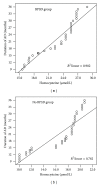Correlation between behavioural and psychological symptoms of Alzheimer type dementia and plasma homocysteine concentration
- PMID: 24995291
- PMCID: PMC4065769
- DOI: 10.1155/2014/383494
Correlation between behavioural and psychological symptoms of Alzheimer type dementia and plasma homocysteine concentration
Abstract
The relationship between plasma homocysteine and behavioral and psychological symptoms of dementia (BPSD) has not been specifically investigated in previous research. In this study, we compared plasma homocysteine (Hcy) among 40 Alzheimer's disease (AD) patients with BPSD, 37 AD patients without BPSD, and 39 healthy controls. Our results evidenced that the plasma homocysteine levels in AD patients with BPSD and without BPSD were higher than healthy controls and that the plasma homocysteine concentration in AD patients with BPSD was the highest among the three groups. Significant correlation between plasma homocysteine concentration and cognitive decline and duration of dementia was observed, but there was no correlation between BPSD and cognitive dysfunction or duration of dementia. In conclusion, this study showed for the first time that BPSD were associated with plasma homocysteine concentration in Alzheimer's dementia, and the results supported that hyperhomocysteine may take part in the pathogenesis of BPSD.
Figures


Similar articles
-
Behavioural and psychological symptoms of Alzheimer type dementia are not correlated with plasma homocysteine concentration.Dement Geriatr Cogn Disord. 2006;22(5-6):432-8. doi: 10.1159/000095802. Epub 2006 Sep 15. Dement Geriatr Cogn Disord. 2006. PMID: 16983185
-
Plasma homocysteine in Alzheimer's disease with or without co-morbid depressive symptoms.Neuro Endocrinol Lett. 2014;35(1):42-9. Neuro Endocrinol Lett. 2014. PMID: 24625917
-
Plasma Homocysteine and Serum Folate and Vitamin B12 Levels in Mild Cognitive Impairment and Alzheimer's Disease: A Case-Control Study.Nutrients. 2017 Jul 8;9(7):725. doi: 10.3390/nu9070725. Nutrients. 2017. PMID: 28698453 Free PMC article.
-
Understanding and managing behavioural symptoms in Alzheimer's disease and related dementias: focus on rivastigmine.Curr Med Res Opin. 2002;18(3):156-71. doi: 10.1185/030079902125000561. Curr Med Res Opin. 2002. PMID: 12094826 Review.
-
Behavioural and psychological symptoms of dementia in Down syndrome: Early indicators of clinical Alzheimer's disease?Cortex. 2015 Dec;73:36-61. doi: 10.1016/j.cortex.2015.07.032. Epub 2015 Aug 13. Cortex. 2015. PMID: 26343344 Review.
Cited by
-
Elevated plasma total homocysteine levels are associated with behavioral and psychological symptoms in dementia with Lewy bodies.Front Neurosci. 2024 Nov 19;18:1406694. doi: 10.3389/fnins.2024.1406694. eCollection 2024. Front Neurosci. 2024. PMID: 39628654 Free PMC article.
-
Effect of memantine combined with citalopram on cognition of BPSD and moderate Alzheimer's disease: A clinical trial.Exp Ther Med. 2019 Mar;17(3):1625-1630. doi: 10.3892/etm.2018.7124. Epub 2018 Dec 21. Exp Ther Med. 2019. PMID: 30783429 Free PMC article.
-
Hyperhomocysteinemia influenced malnutrition in Parkinson's disease patients.Neurol Sci. 2018 Oct;39(10):1691-1695. doi: 10.1007/s10072-018-3480-5. Epub 2018 Jun 30. Neurol Sci. 2018. PMID: 29961201
-
Association between malnutrition and hyperhomocysteine in Alzheimer's disease patients and diet intervention of betaine.J Clin Lab Anal. 2017 Sep;31(5):e22090. doi: 10.1002/jcla.22090. Epub 2016 Nov 7. J Clin Lab Anal. 2017. PMID: 28671332 Free PMC article. Clinical Trial.
-
Best practice in the management of behavioural and psychological symptoms of dementia.Ther Adv Neurol Disord. 2017 Aug;10(8):297-309. doi: 10.1177/1756285617712979. Epub 2017 Jun 19. Ther Adv Neurol Disord. 2017. PMID: 28781611 Free PMC article. Review.
References
-
- Fuentealba RA, Farias G, Scheu J, Bronfman M, Marzolo MP, Inestrosa NC. Signal transduction during amyloid-β-peptide neurotoxicity: role in Alzheimer disease. Brain Research Reviews. 2004;47(1–3):275–289. - PubMed
-
- Association IP. Research methodological issue in evaluating behavioral disorders of dementia. International Psychogeriatrics. 1996;8(3):215–218. - PubMed
-
- Qu HF, Zhang H, Sheng JH, Gao ZX. Comparison of the behavioral disorder in Alzheimer's disease and vascular dementia patients. Journal of Clinical Psychological Medicine. 2003;13(5):287–288.
-
- Tariot P, Blazina L. The psychopathology of dementia. Neurological Disease and Therapy. 1994;22(1):p. 461.
-
- Wei J, Li HW. Progress in clinical research of Alzheimer's disease. Journal of Qiqihar Medical College. 2008;29(21):p. 2633.
MeSH terms
Substances
LinkOut - more resources
Full Text Sources
Other Literature Sources
Medical

